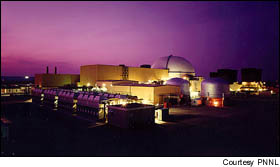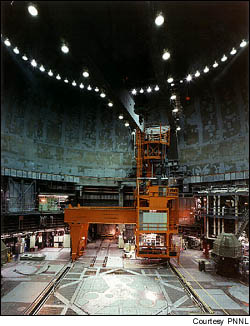forum
library
tutorial
contact

Last Hurrah for Hanford Reactor
Mike StarkEnvironmental News Network - November 28, 2000
|
the film forum library tutorial contact |

|
Last Hurrah for Hanford ReactorMike StarkEnvironmental News Network - November 28, 2000 |
After years of contentious debate and political rancor, the federal government says a controversial nuclear reactor in Washington state should be permanently shut down.
 The U.S. Department of Energy said the Hanford, Washington, test reactor, dormant since 1992, shouldnít be restarted to produce medical isotopes or plutonium for space missions. The decision, listed now as a "preferred alternative" and expected to be finalized in January, marks the beginning of the end to one of the hottest U.S. nuclear debates in years: closure of the Hanford Nuclear Reservation in eastern Washington.
The U.S. Department of Energy said the Hanford, Washington, test reactor, dormant since 1992, shouldnít be restarted to produce medical isotopes or plutonium for space missions. The decision, listed now as a "preferred alternative" and expected to be finalized in January, marks the beginning of the end to one of the hottest U.S. nuclear debates in years: closure of the Hanford Nuclear Reservation in eastern Washington.
"This issue has divided the region and prevented us from working together for cleanup," said Gerald Pollet, executive director of Heart of America Northwest, a citizen-run Hanford watchdog group. "We have had four years of being called names, being subjected to threats and even physical assaults as we tried to work for the cleanup of Hanford, instead of adding more wastes to our problems."
Polletís group and others say restarting the test reactor would only add to Hanfordís nuclear waste, exacerbate existing problems with leaks and faulty tanks, and further delay cleanup at Hanford, the nationís most contaminated nuclear site.
The reactor, known as the Fast Flux Test Facility, was built in the 1970s to test nuclear fuels and components. When it shut down eight years ago, energy officials started looking for other uses for the reactor, including the production of plutonium for NASA space missions and isotopes to diagnose and treat cancer and other illnesses.
Supporters of the reactor, particularly those in the Tri-Cities area near Hanford, have said the FFTF could play a vital role in improving medical care and research. But Energy Department officials said there isn't enough convincing evidence to stoke up the reactor again.
"The missions, while of great interest ... were not concrete enough to proceed at this time," said Bill Magwood, an Energy Department undersecretary. The Energy Department will look into producing plutonium for space missions at other sites in Idaho and Tennessee. The department said it would also consider generating medical isotopes at other facilities.
The fight over the future of the test reactor has grown over the years. Thousands of citizens attended public meetings about the facility, and the Energy Department investigated different options. Opponents worried that more activity at Hanford, which operated from 1944 until the late 1980s, would further jeopardize the nearby Columbia River, which provides irrigation and hydroelectricity for the region and hosts several species of endangered salmon.
 Hanford, created as part of the
Manhattan Project, is already the
focus of the world's largest
environmental cleanup project.
Hanford, created as part of the
Manhattan Project, is already the
focus of the world's largest
environmental cleanup project.
The decision not to restart the test reactor was seen as a clear victory for conservation groups and others trying to clean up Hanford and the Columbia River. Some, though, worried that the decision might be overturned by the next presidential administration.
"There was massive pressure from nuclear special interests and citizens of the Tri-Cities to restart this archaic machine," said Greg deBruler, Hanford consultant for Columbia Riverkeeper, a conservation group. "Secretary of Energy Bill Richardson made a difficult and courageous decision."
Sen. Ron Wyden, D-Oregon, said the Energy Department has wasted $30 million a year on a "scavenger hunt" to find a new mission for the FFTF at Hanford.
"Now, the supposed justifications for restart have completely evaporated and the funds that are being wasted will go where they have long belonged: into cleaning up the environment that adjoins our lifeblood, the Columbia River," Wyden said. "After years of indecision, the people of the Pacific Northwest deserve to have the money used to clean up the contamination at Hanford rather than on some wild good chase."
Deactivating the reactor could cost about $280 million.
learn more on topics covered in the film
see the video
read the script
learn the songs
discussion forum